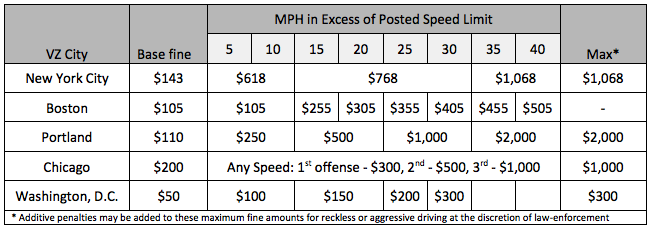AAA Mid-Atlantic: “Yeah, let’s not make our roads safer.”

Image by Cgrus Yarzab licensed under Creative Commons.
Unsafe driving is a major problem in DC, and to fix it the District should ticket drivers less frequently and make fines cheap. At least, that’s what AAA Mid-Atlantic had to say in its recent comments about traffic offenses and fines in the city.
Traffic rules in DC will soon get a makeover as part of a multi-year rulemaking effort led by the District Department of Transportation. The idea is to adjust rules related to dangerous behaviors like speeding, running red lights, failure to yield, or making illegal turns. The rulemaking is part of DC’s Vision Zero initiative, which seeks to eliminate traffic fatalities in the District by 2024.
According to AAA, the problem is too much enforcement
In its comments, made available via a FOIA request by Ward 6 ANC commissioner Mark Eckenwiler, AAA Mid-Atlantic focuses on two red herrings that often shift attention away from drivers’ risky and unsafe behaviors: first, it says that drivers in DC are over-ticketed compared to drivers elsewhere. Second, it argues about drivers’ pocketbooks, saying existing fines are already too high and burdensome for drivers.
Regarding trying to shift our focus toward the number of tickets that DC issues, AAA says:
On average, the District issues nearly 2.5 million parking, photo-enforcement, and moving violation tickets annually, as it did in 2013. It is an average of nearly four citations for each resident in Washington, D.C. proper…Year-in and year-out, the District issues more traffic tickets than all of the surrounding jurisdictions combined…
Four citations per resident is a good soundbyte, but it’s a bad statistic.
“Residents” isn’t a particularly useful metric for assessing enforcement in a city that hosts thousands of non-resident drivers daily, and including more than one million parking tickets serves to increase the total with tickets that can be as benign as running out of time at a meter. In recent years, photo enforcement and moving violation tickets have totaled around 500,000 to 1 million.
But the main problem with this argument is that the number of tickets issued does not matter; curtailing dangerous driver behavior does. If it takes twice as many tickets to reduce extreme speeding, driving under the influence, or other risky behaviors, DC should absolutely issue them and hold drivers to account for their behaviors.
Ironically, while decrying the number of tickets DC issues, AAA also calls for “high-visibility traffic enforcement” in “areas of high incidence of crashes with vulnerable users and motorists.” AAA Mid-Atlantic basically writes the thesis statement for DC’s Automatic Traffic Enforcement program (e.g., speed and red-light cameras) mere sentences away from complaining about the resulting volume of automated traffic tickets.
And by the way, automated enforcement is having a positive effect on safety. DDOT recently compared crash data from three years before and after camera installation at current camera locations.
Image by DDOT.
At red light camera locations, total crashes fell 26 percent, and serious injuries were reduced 71 percent. At speed cameras, total crashes fell 16 percent, serious injuries 41 percent, and fatalities by 80 percent. Not only were there fewer total incidents, but the remaining incidents were much less severe.
AAA compares DC’s fines to states, not other cities
AAA’s second concern is that DC’s existing and proposed fines are higher than those for comparable offenses in Virginia and Maryland:
Generally, the current amount of traffic ticket fines in the nation’s capital is already the exception to the rule - they are more expensive - for routine tickets for speeding; using a phone while driving; texting while driving; and passing a vehicle stopped for a pedestrian at a crosswalk.
It is challenging to figure out what traffic fines should cost. There is evidence that lower fines, when applied and enforced with regularity, could do more to change behaviors than high fines that are enforced rarely or selectively. But either way, comparing DC’s fines to statewide fines in neighboring states confuses regulations designed for an urban environment with those made for a mix of urban, suburban and rural areas.
A better comparison is the one DDOT did to look at speeding ticket fines across several “peer” cities as part of its rulemaking.
Image by DDOT.
Under this comparison, a different story emerges: one where DC’s fines lag those of its peers, especially considering fines for reckless speeding at 20-25+ mph over the limit.
DC is a dense urban environment with tightly-spaced intersections and lots of pedestrians and bicyclists sharing space with other drivers. The risks to others for engaging in reckless driving are more immediate and severe than the risks of similar actions in rural areas. Fines should be higher in cities because the consequences of not driving your vehicle safely are higher.
Also, the consequences of excessive speeding are dire. AAA’s own research has found that on average, a pedestrian struck by a vehicle at around 25 mph survives 90 percent of the time, but someone struck at 50 mph dies 75 percent of the time. Penalties should be high for such illegal, dangerous behaviors.
If we want safer streets, we need punishments for breaking the rules
At one point in its comments, AAA Mid-Atlantic says that DC, “should strive to find the right balance of safety initiatives to change the paradigm and to make the city’s routes and roads safer for all highway users.” Indeed.
But instead of helping, the rest of their comments recommend that DC be lenient on risky drivers and absolve dangerous drivers of the consequences of their bad behavior, at the expense of every other road user — motorists, cyclists, and pedestrians alike — put at risk by that behavior.
